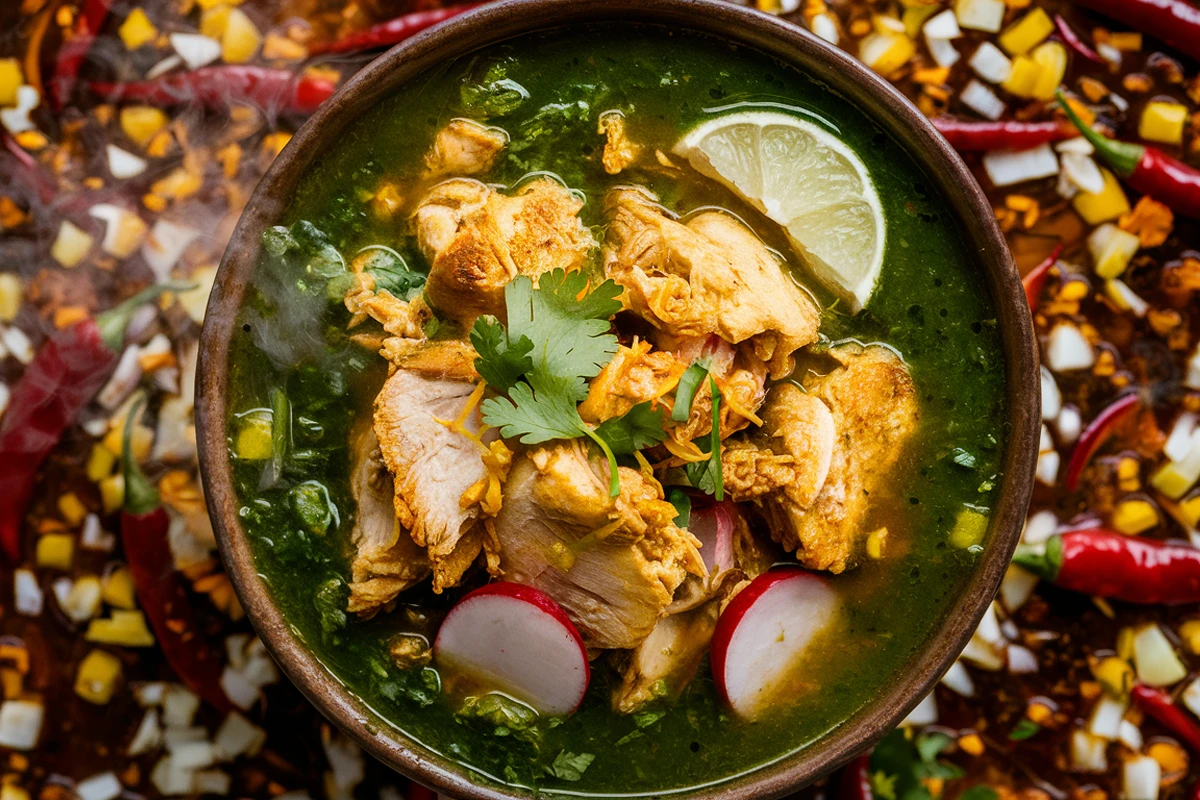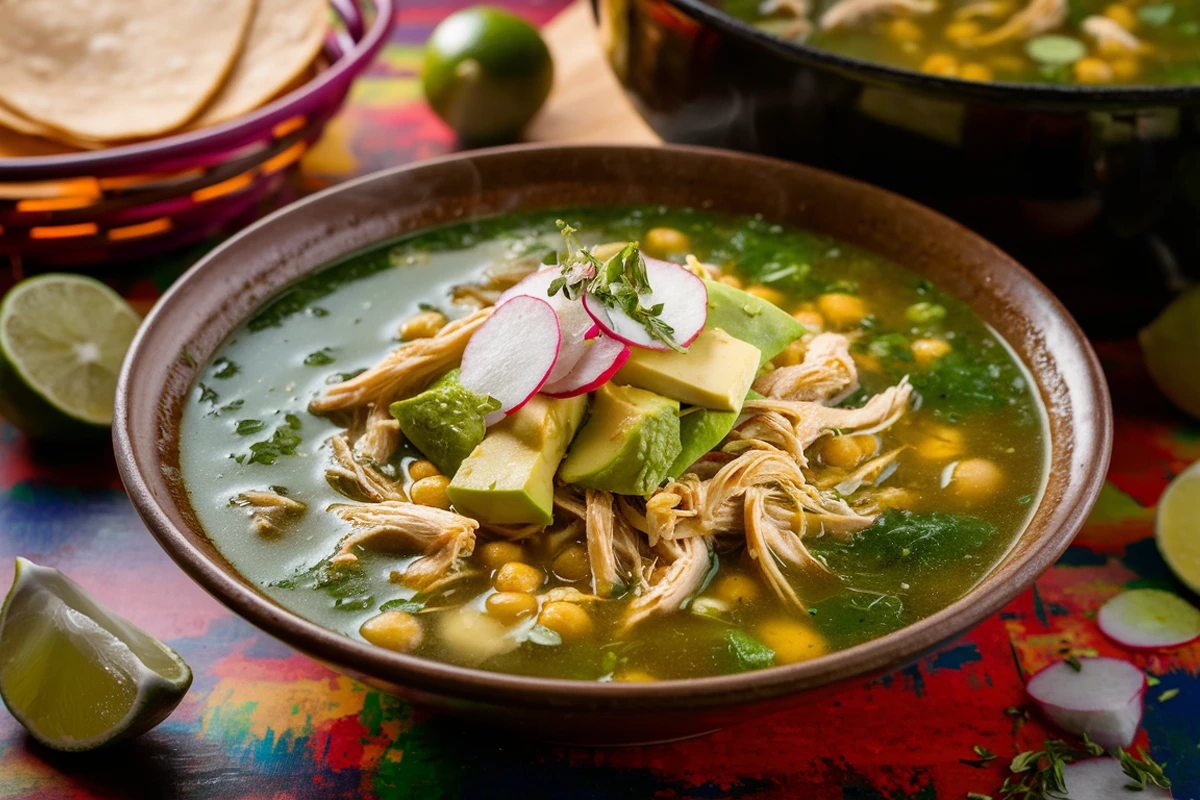Overview of Pozole Verde Recipe Chicken
What Makes Pozole Verde Unique?
Pozole Verde Recipe Chicken, a beloved Mexican stew, is traditionally made with pork, hominy, and a broth seasoned with a blend of chilies. While Pozole Rojo is celebrated for its deep, red chili flavor, and Pozole Blanco is known for its simpler, chili-free broth, Pozole Verde stands out with its fresh and tangy green broth. This version is not only eye-catching but also offers a lighter, yet equally satisfying taste profile that comes from its base of tomatillos, cilantro, and green chilies.
Pozole Verde is typically enjoyed during large gatherings, from family dinners to festive celebrations, embodying a dish that is both a comfort food and a party staple. Its versatility in terms of ingredients and toppings makes it a favorite among cooks who appreciate a recipe that they can make their own.
The uniqueness of Pozole Verde lies in its combination of simple ingredients that transform into something truly extraordinary. The use of hominy, large corn kernels that have been nixtamalized (soaked and cooked in an alkaline solution), gives the dish its distinctive texture and flavor, which is a cornerstone of its identity.
As we explore how to create this delightful dish, we’ll delve into each ingredient’s role and how they come together to create a comforting bowl of pozole that warms the soul. Stay tuned as we walk through the preparation steps, ensuring you can bring this traditional Mexican fare into your kitchen with confidence and flair.
Essential Ingredients
Key Ingredients Explained
The foundation of any Pozole Verde starts with selecting the right ingredients. Here’s a closer look at the key components that bring this dish to life:
- Hominy: This is the star of the dish, giving Pozole Verde its characteristic heartiness. Hominy is corn that has undergone a process called nixtamalization, which softens the kernels and enhances their flavor. It’s available canned or dried, but for convenience, most cooks prefer the canned version.
- Chicken: For a flavorful pozole, opt for boneless, skinless chicken thighs because they are juicier and more tender than breasts. They hold up well during the simmering process, absorbing the rich flavors of the broth.
- Tomatillos: These small, green “Mexican husk tomatoes” are essential for the verde sauce. They provide a fresh, tangy taste that is the backbone of the dish’s vibrant green broth. Make sure to remove their husks and wash them before use.
- Jalapeños and Cilantro: These ingredients add the necessary kick and a layer of depth to the broth. Jalapeños can be adjusted according to heat preference, while cilantro brings its unmistakable fresh and citrusy note.
Substitutions and Variations
Flexibility is one of the joys of cooking Pozole Verde. Here are some tips for substituting ingredients if you need to tweak the recipe:
- If hominy is unavailable, you can substitute it with large white corn kernels, though the texture will slightly differ.
- For a milder version, replace jalapeños with poblanos, which are less spicy but still flavorful.
- Vegetarians can substitute chicken with jackfruit or large white beans, which provide a similar texture.
Explore the history of Mexican cuisine to understand how these ingredients play into broader culinary traditions. This background enriches the cooking experience, making your Pozole Verde not just a meal, but a story on a plate.
Step-by-Step Cooking Guide
Preparation of Ingredients
Before embarking on the cooking journey, it’s crucial to give your ingredients the proper attention they deserve. This will make the cooking process smoother and ensure that flavors meld perfectly:
- Hominy: If using dried hominy, soak it overnight in water to soften. Canned hominy should be rinsed and drained to remove any preservatives and to freshen up its taste.
- Chicken: Trim any excess fat from the chicken thighs and cut them into large chunks to ensure they cook evenly and are easy to shred later.
- Tomatillos: After removing the husks, wash the tomatillos thoroughly to remove the sticky residue on their surface. Cut them in half to expose their interior to the broth, enhancing their flavor contribution.
- Jalapeños: To control the heat level, you can remove the seeds and membranes from the jalapeños before chopping them. If you prefer a spicier stew, leave some or all of them intact.
Cooking Process Detailed
Now, let’s get cooking! Follow these detailed steps to bring your Pozole Verde to life:
- Cook: In a large pot or Dutch oven, combine the chicken, hominy, tomatillos, jalapeños, and enough water or chicken broth to cover the ingredients.
- Simmer: Once boiling, reduce the heat to a simmer. Cover the pot partially to allow some steam to escape, and cook for about 40 minutes. The chicken should be tender and fully cooked, and the tomatillos soft and breaking down.
- Blend: Using a slotted spoon, remove the cooked tomatillos, jalapeños, and some of the onions and garlic (if using) from the pot. Place them in a blender along with a handful of fresh cilantro. Add a cup of the cooking liquid to help blend into a smooth sauce.
- Shred: While the sauce blends, remove the chicken from the pot and shred it using two forks. It should pull apart easily if fully cooked.
- Combine: Return the shredded chicken to the pot and stir in the blended green sauce and hominy.
- Final Simmer: Let the pozole simmer for an additional 15 minutes to meld the flavors. Taste and adjust the seasoning with more salt or a squeeze of fresh lime juice if desired.
This simmering process not only cooks the ingredients but also allows the flavors to deepen and blend together, resulting in a rich, comforting stew. The final product should be a hearty, flavorful bowl of Pozole Verde that’s both satisfying and vibrant.
Tips and Techniques
Expert Cooking Tips
Creating a memorable Pozole Verde Recipe Chicken involves more than just following a recipe; it’s about mastering a few techniques that elevate your dish:
- Layering Flavors: Start by sautéing onions and garlic in the pot before adding other ingredients. This base adds a depth of flavor that infuses the entire dish.
- Balancing Heat: Adjust the heat by varying the type of peppers used. If jalapeños are too spicy, consider milder alternatives like poblanos or even green bell peppers for a very mild flavor.
- Using Fresh Ingredients: Fresh cilantro, freshly squeezed lime juice, and freshly ground spices will enhance the vibrancy and taste of your pozole, making it stand out.
Common Mistakes to Avoid
Even experienced cooks can encounter pitfalls when making Pozole Verde.
- Overcooking the Hominy: Hominy should be tender but still have a bite. Overcooking it can lead to a mushy texture that detracts from the dish.
- Skimping on Seasoning: This dish relies on its robust seasoning for flavor. Be sure to taste as you go and adjust the seasoning, especially after adding the blended sauce.
- Ignoring the Simmer: The simmering step is crucial for allowing the flavors to meld. Rushing this process can result in a less cohesive and flavorful pozole.
Learn more about the health benefits of hominy, which not only contributes to the nutritional value of the dish but also to its unique texture and taste. Understanding these benefits can make your cooking experience even more rewarding.
Serving and Presentation
How to Serve Pozole Verde
Serving Pozole Verde effectively is about enhancing its natural flavors and presenting it in a way that appeals to the senses. Here’s how to do it right:
- Choosing the Right Bowls: Serve pozole in deep bowls to accommodate a generous amount of broth along with the hominy and chicken. This also makes it easier to add and mix in various toppings.
- Garnishing: Offer a variety of garnishes on the side so everyone can customize their bowl. Typical garnishes for pozole include diced onions, sliced radishes, shredded lettuce or cabbage, diced avocados, chopped cilantro, and lime wedges. These add crunch, freshness, and a burst of color.
- Warm Tortillas on the Side: Providing warm tortillas or tortilla chips on the side allows guests to enjoy a textural contrast with their pozole, making the meal more satisfying and complete.
Plating Techniques
The presentation of Pozole Verde can elevate it from a simple meal to an extraordinary experience. Here are some tips for plating:
- Color Balance: Make sure there’s a good balance of green from the cilantro and lime, red from the radishes, and white from the onions. This not only makes the dish more appealing but also reflects the vibrant colors of Mexican cuisine.
- Layering Toppings: Strategically place the toppings for visual appeal. For instance, radishes and onions can be placed on opposite sides of the bowl, with a sprinkle of cilantro in the center and a lime wedge on the rim.
- Serving Sequence: Serve the broth and hominy first, followed by the chicken, and then invite guests to add their own toppings according to their preference. This interactive element can make dining more engaging and personalized.
With these serving and presentation tips, Pozole Verde can truly shine as the centerpiece of your meal, delighting both the eyes and the palate.
Storage and Make-Ahead Tips of Pozole Verde
Storing Leftovers
Pozole Verde is just as delightful the next day, if not more, as the flavors continue to meld in the refrigerator. Here’s how to store it properly:
- Cooling Down: Allow the pozole to cool to room temperature before storing. This prevents condensation inside the container, which could make the pozole soggy.
- Airtight Containers: Transfer the pozole to airtight containers. This keeps out contaminants and preserves the flavors and textures of the ingredients.
- Refrigeration: Store the pozole in the refrigerator where it will keep for up to 5 days. Make sure it’s covered tightly to avoid absorbing other flavors from the fridge.
Freezing and Reheating Guidelines
Freezing Pozole Verde can extend its enjoyment even further. Follow these steps for freezing and reheating:
- Portion Control: Freeze the pozole in individual portions for convenience. This allows you to thaw only what you need for each meal.
- Freezing: Use freezer-safe bags or containers to freeze the pozole.
- Thawing and Reheating: Thaw frozen pozole in the refrigerator overnight. Reheat on the stove over medium heat until it is thoroughly warmed through. Stir occasionally to ensure even heating and to prevent the bottom from sticking.
Tips for cooking with tomatillos can also be useful when making Pozole Verde, as they form the base of the green sauce that characterizes this dish. Proper handling and cooking of tomatillos can make a significant difference in the flavor and quality of your pozole.
Nutritional Information of Pozole Verde
Health Benefits
Pozole Verde isn’t just delicious; it’s also packed with nutrients that make it a wholesome choice for a meal. Here’s a closer look at the nutritional benefits of the key ingredients:
- Hominy: Hominy is made from corn kernels that have been treated through nixtamalization, improving their nutritional value. This process increases the availability of niacin (vitamin B3) and makes the protein in the corn more digestible. Hominy is also a good source of fiber, which aids in digestion.
- Chicken: As a lean source of protein, chicken helps in muscle repair and growth. It is also a good source of vitamins B6 and B12, which are crucial for energy production and brain health.
- Tomatillos: These are low in calories but high in vitamins C and K, potassium, and manganese. Vitamin C is an antioxidant that helps protect your cells from damage, while vitamin K is essential for blood clotting and bone health.
- Jalapeños: While they add a kick to the dish, jalapeños also bring some health benefits. They contain capsaicin, which has been shown to boost metabolism and aid in fat burning. Jalapeños are also a good source of vitamin C.
- Cilantro: Often used as a garnish, cilantro is more than just a decorative herb. It has detoxifying properties, thanks to its high antioxidant content. It also has antibacterial qualities and can help reduce heavy metal toxicity in the body.
Nutritional Breakdown
Here’s a rough breakdown of the nutritional content per serving of Pozole Verde (approximately one bowl):
- Calories: 250-300
- Carbohydrates: 24-28 grams
- Protein: 20-25 grams
- Fat: 7-10 grams
- Fiber: 4-5 grams
- Sugars: 6-7 grams
The exact numbers may vary based on the specific ingredients used and their quantities, but this gives you a good idea of how nourishing a bowl of Pozole Verde can be.
FAQs About Pozole Verde
What is chicken pozole verde made of?
Chicken pozole verde consists mainly of shredded chicken, hominy, and a vibrant green sauce. Crafted from tomatillos, jalapeños, and cilantro, this sauce lends the dish its characteristic fresh and tangy flavor.
What’s the difference between pozole and pozole verde?
The key distinction lies in the sauce. Traditional pozole often features a red chili sauce, making it richer and deeper in flavor. Conversely, pozole verde is made with a green sauce, which offers a lighter, zestier taste profile.
What is pozole sauce made of?
Pozole sauce varies by type. For pozole verde, the sauce includes pureed tomatillos, green chilies, and cilantro. This mixture creates a tangy and herbaceous flavor foundation that distinguishes it from other varieties.
What are the 3 types of pozole?
Primarily, pozole comes in three variations: rojo (red), blanco (white), and verde (green). Pozole rojo utilizes a red chili pepper base, blanco is served without any chili sauce, and verde uses a green sauce made from tomatillos and green chilies.
Conclusion
In summary, pozole verde recipe chicken stands out as a vibrant and flavorful dish in the realm of Mexican cuisine. Its unique green sauce, crafted from tomatillos, jalapeños, and cilantro, imparts a fresh and tangy flavor that is both inviting and comforting. This dish not only pleases the palate but also offers a variety of nutritional benefits, making it a wholesome choice for any meal.
Moreover, the versatility of pozole verde recipe chicken allows for creating numerous variations, ensuring that it can tailor to different taste preferences and dietary needs. Whether you opt for a spicier version by adding more jalapeños or a vegetarian adaptation using jackfruit, the essence of this traditional stew remains intact.
Furthermore, the detailed guide provided here equips you with all the necessary knowledge to master this dish, from selecting the right ingredients to perfecting the cooking process. As you embrace the techniques and tips shared, you’ll find that making Pozole Verde becomes an enjoyable and rewarding experience.
Finally, Remember the success of Pozole Verde lies in balancing its ingredients and preparing it with love. So, gather your pozole verde recipe chicken, follow these steps, and prepare to delight in a dish that truly embodies the spirit of Mexican culinary tradition. Enjoy your cooking pozole verde recipe chicken journey and the delicious meals that await!



